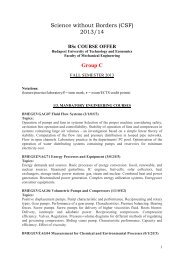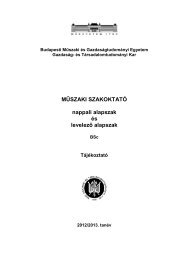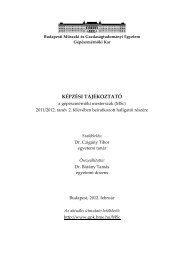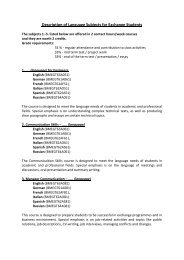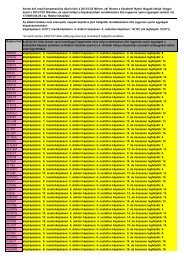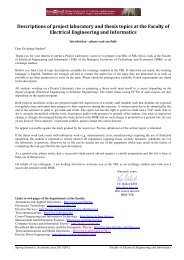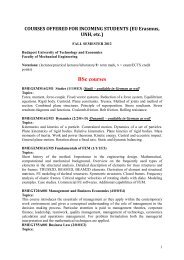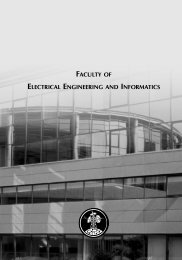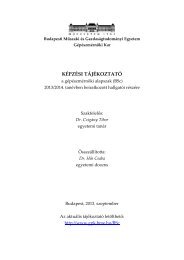FACULTY OF CHEMICAL TECHNOLOGY AND BIOTECHNOLOGY
FACULTY OF CHEMICAL TECHNOLOGY AND BIOTECHNOLOGY
FACULTY OF CHEMICAL TECHNOLOGY AND BIOTECHNOLOGY
You also want an ePaper? Increase the reach of your titles
YUMPU automatically turns print PDFs into web optimized ePapers that Google loves.
<strong>FACULTY</strong> <strong>OF</strong> <strong>CHEMICAL</strong> <strong>TECHNOLOGY</strong> <strong>AND</strong> BIO<strong>TECHNOLOGY</strong>Polymer ProcessingBMEVEMGA608Dr. Béla PukánszkyIntroductionRheology - flow, viscosityThe measurement of the characteristics of the melt (viscosity,elastic properties)Heat transfer processesExtrusion - equipment, basic processesExtrusion - dies, productsInjection molding - equipment, the mould filling processInjection molding - the structure of injection molded products;moldsExtrusion and injection blow molding, rotational moldingCalenderingWelding and other operationsProcessing of thermoset resinsOther processing technologiesPolymer Physics Laboratory PracticeBMEVEMGA509Dr. Béla PukánszkyIntroductionPreparation and reactions of polymersQualitative analysis of polymersRheologyIR spectroscopyThermal analysis IThermal analysis IIImpact testingMechanical properties of polymersFibre-reinforced compositesPolymer foamsWelding of polymersPolymer AdditivesBMEVEMGA610Dr. Béla PukánszkyIntroduction. Changes taking place during the processingand application of plastics, chemical reactions, degradation,ageing. Degradation and stabilization. Light stabilization.PVC degradation and stabilization. Degradation and stabilizationof other polymers. Lubricants. Fillers, surfactants,coupling agents. Polymer additives (impact modifiers, processingaids). The purpose of their application, mechanism.Flame retardants. Blowing agents, colorants. Other additives.Further aspects of the application of additives. Additive packages,interaction of additives - PVC, polyolefinsPolymer PhysicsBMEVEMGA511Dr. Béla PukánszkyIntroduction. Terms and definitions: monomer, polymer,homo- and copolymer. Structure of the polymer, segments,entanglement. Supermolecular structure, amorphous andcrystalline materials.The individual chain. Shape, conformation, conformationdistribution. The freely joined chain model. Interactions, solutions,determination of molecular weight. Phases and physicalstates, termomechanics. Rubber elastic state, thermodynamics.Rubber elastic state, kinetics. Flow, rheology.Measurement of viscosity. Glassy state, fracture, polarizationoptics. Crystalline polymers, structure. Crystallization kinetics,melting. Structure-property correlations, plasticizationBranch of Textile TechnologyExperimental Methods in Material ScienceBMETE12AX12Dr. Ferenc RétiBonding and structure in solids (crystal geometry, glasslikematerials). Properties of the electron structure in solids,formation of the bands from atomic levels in metals and isolators.Density of states and density of optical states.Vibrations in solids. Differences between the crystalline andamorphous materials. Crystal defects, surfaces and theireffects. Methods using the excitation of the electronic structure(XPS, UPS, AES, SIMS, absorption spectroscopy of thesolids. Methods using the excitation of the lattice.Thermoanalytique, IR and Raman spectroscopy. Methods forstudying the structure (XRD, SEM + EDX, SPM ((EC)-STM,(EC)-AFM, nanoidentator)).Chemistry and Technology of MacromoleculesBMEVEMGA504Dr. Emilia CsiszárTypes of polyreactions: polymerization, polycondensation,polyaddition and other new polymerization reactions.Classification of chain polymerization reactions: radical,anionic, cationic and stereospecific polymerization. Theoryof free radical polymerization. Elementary reactions of radicalpolymerization. Types of initiators and the characteristics oftheir decomposition kinetics. Mechanism of chain propagation,termination and chain transfer reactions. Inhibition ofradical polymerization. Theory of copolymerization.Characteristics of anionic and cationic polymerization. Livinganionic and cationic polymerization and their significance inpreparative polymer chemistry. Stereospecific polymerization.Mechanism and kinetics of polycondensation andpolyaddition reactions. Chemical reactions of polymers.Types of cross-linking reactions. Degradation and stabilizationof polymers.Fibre Forming PolymersBMEVEMGA512Dr. Judit BorsaPhyisical and chemical properties of fibre forming macromolecules,groups of fibre types, properties of fibres and theirrole in the practice, natural fibres (cellulosic fibres, wool, silk),natural polymer based man made fibres (regenerated cellulosefibres), synthetic fibres (polyamides, polyesters, polyacrylnitrils),technologies of fibre manufacturing, specialfibres and applications.Chemistry of Dyes and SurfactantsBMEVEMGA514Dr. András VígColouristic knowledge will be presented based upon thecorrelation between the colour and structure of dyes.Systems, production, chemical and technological characteristicsand application of dyes and surfactants on the field ofmacromolecular systems as specially of fibrous ones will bepresented. Methods of fastness property investigations of dyedsystems (e.g. light fastness, rubbing fastness, wash fastness) areincluded. Optimal water and energy consumption as well asthe reduction of environmental pollution will also be discussed.75



